© 2014-


Radio Nord - History (2)
Unfortunate ly a series of unexpected incidents frustrated the station's well laid plans to be on the air for Christmas. Only two and a half hours after leaving Copenhagen the Captain of the Bon Jour decided to drop anchor for a few hours as the weather was becoming extremely foggy. The voyage resumed the following day, but at 5.00pm, just over half way through the journey to the Bon Jour's intended anchorage, the Captain again dropped anchor off the island of Gotska Sandon. The problem this time was that the stays on the mast had worked loose during severe gales and it was thought necessary to repair the damage before sailing on. On 23rd December the Bon Jour set sail again, anchoring a few hours later at what the Captain thought was the correct position. Engineers switched on the transmitter but the aerial short-
ly a series of unexpected incidents frustrated the station's well laid plans to be on the air for Christmas. Only two and a half hours after leaving Copenhagen the Captain of the Bon Jour decided to drop anchor for a few hours as the weather was becoming extremely foggy. The voyage resumed the following day, but at 5.00pm, just over half way through the journey to the Bon Jour's intended anchorage, the Captain again dropped anchor off the island of Gotska Sandon. The problem this time was that the stays on the mast had worked loose during severe gales and it was thought necessary to repair the damage before sailing on. On 23rd December the Bon Jour set sail again, anchoring a few hours later at what the Captain thought was the correct position. Engineers switched on the transmitter but the aerial short-
Radio Nord's owners had sent special Christmas programme tapes on board a fishing boat, the Dannette which had instructions to rendezvous with the Bon Jour when she arrived at the prearranged anchorage position. Because the Captain had anchored the Bon Jour in the wrong location the Dannette spent two days searching for the radio ship, eventually finding her on Christmas Eve 1960.
On Christmas Day, instead of the planned opening of Radio Nord the crew actually abandoned ship, thinking that the mast was about to collapse on the deck. They were taken to Sandhamn by a pilot vessel, leaving the Bon Jour riding at her anchorage unmanned. The following day they were persuaded to return to the radio ship and on 27th December 1960 the Bon Jour was towed into Sandhamn by a salvage tug.
The radio ship was later taken to Lidingo for repairs, but on arrival there the crew discovered that the shipyard had closed down six months earlier! Amidst this fiasco and with press demands for the Swedish authorities to declare the Bon Jour unseaworthy, the vessel briefly visited Stockholm before leaving hurriedly for Abo in Finland to avoid being impounded by Swedish government marine inspectors.
1961
After entering the Crichton-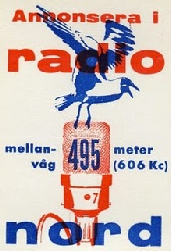 ged to take command of the radio ship. However, the Finnish Government, at the request of their Swedish counterparts, pressurised the shipyard into refusing a repair berth for the vessel, so once again the Bon Jour was forced to set sail, anchoring in nearby Chalk Harbour. The shipyard owner, who was personally very sympathetic towards the station, arranged for a party of workers to travel to the ship and carry out repairs at sea, a task which was completed on 4th February 1961.
ged to take command of the radio ship. However, the Finnish Government, at the request of their Swedish counterparts, pressurised the shipyard into refusing a repair berth for the vessel, so once again the Bon Jour was forced to set sail, anchoring in nearby Chalk Harbour. The shipyard owner, who was personally very sympathetic towards the station, arranged for a party of workers to travel to the ship and carry out repairs at sea, a task which was completed on 4th February 1961.
Two days later the radio ship anchored off Orno, but just as final engineering checks were being carried out the insulators fractured and yet again the Bon Jour was forced to go into port at the Finnboda shipyard in Stockholm. Here new insulators were installed, all equipment checked and, despite the transmitters having been sealed by the Swedish authorities the crew had discovered a way to bypass the seals and a number of test transmissions were made from the ship while she was still anchored in central Stockholm.
Having completed the repairs and technical overhaul the Bon Jour was able to leave port on 21st February 1961 and sailed once again for her anchorage off Stockholm. Shortly afterwards the first test transmissions were made, but after a day or two the condensers started causing problems and the ship returned yet again to the Finnboda shipyard.
By 1st March 1961 the ship was back at her anchorage and had resumed test transmissions. The repairs at the Stockholm shipyard had been completed just before the Swedish Government passed a law stating that any radio ship entering their territorial waters would have its transmitting equipment removed and confiscated.
After two and a half months of frustrating delays and frequent visits to port for repairs to the ship and transmitting equipment, Radio Nord was finally able to begin official programmes at 10.00am on 8th March 1961. On that opening day the station ended its transmissions at 6.00pm in the evening, but the following day programmes started again at 6.00am and within a very short time Radio Nord was broadcasting 24 hours a day.
Once regular tran smissions had started the Swedish Government put pressure on Nicaragua to withdraw registration from the Bon Jour. The station managed to arrange alternative registration with Panama, but to do this had to change the ship's name yet again, this time to Magda Maria.
smissions had started the Swedish Government put pressure on Nicaragua to withdraw registration from the Bon Jour. The station managed to arrange alternative registration with Panama, but to do this had to change the ship's name yet again, this time to Magda Maria.
Radio Nord's programmes were a mixture of live broadcasts from the ship and pre-
The format Radio Nord offered its listeners was something completely new to Europ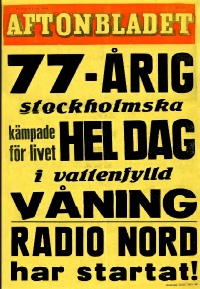 e. Even the other contemporary offshore radio stations off the coasts of Denmark and Holland did not produce their programmes in the American-
e. Even the other contemporary offshore radio stations off the coasts of Denmark and Holland did not produce their programmes in the American-
a) no listener tuning into the station should have to switch off because the kind of music they preferred would not be heard within a reasonable time;
b) everyone should be able to turn programmes on and off when they pleased, without being tied to particular programme times.
From the start too, the maximum time between each record -
The guiding light behind this programme policy was, of course, Gordon McLendon, whose station in Dallas, KLIF, had successfully pioneered such a format. KLIF was particularly strong on news with the slogan "Tomorrow's 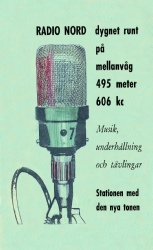 Newspaper Today". News was broadcast every hour, with headlines every half hour and no item was allowed to be presented in the same style twice. If nothing had happened to update a story since the previous newscast then it was rewritten so that it sounded fresh to the listener. KLIF also employed mobile units to gather news around Dallas and for on-
Newspaper Today". News was broadcast every hour, with headlines every half hour and no item was allowed to be presented in the same style twice. If nothing had happened to update a story since the previous newscast then it was rewritten so that it sounded fresh to the listener. KLIF also employed mobile units to gather news around Dallas and for on-
The use of this latter facility was obviously impossible for an offshore station, but Radio Nord nevertheless managed to develop a very efficient news operation, possibly the most sophisticated of any offshore station. Negotiations with news agencies such as Associated Press and United Press International for a direct teleprinter feed to the radio ship came to nothing, but undaunted by this setback an ingenious news-

A two part documentary film showing Radio Nord from the Bon Jour in 1961

Click on picture to enlarge
Aftonbladt
placard 27th December 1960
‘SOS -
Ingemar Lindqvist
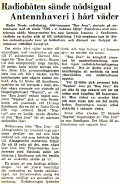
Dagens Nhyter
27th December 1960
Ingemar Lindqvist

Expressen
22nd December 1960
Ingemar Lindqvist
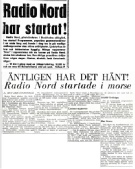
Aftonbladet
5th March 1961
Ingemar Lindqvist
Aftonbladet placard. 5th March 1961
‘ Radio Nord has started’
Ingemar Lindqvist

History
Key Dates
Ship and Location
Technical
Staff
Programmes





Click to enlarge
Turtlewax



Duralex



Pepsodent Toothpaste



Commercials and Programme Trailers courtesy Ingemar Lindqvist
Treasure Chest


Back to Radio Nord

Back to Scandinavia Gallery

